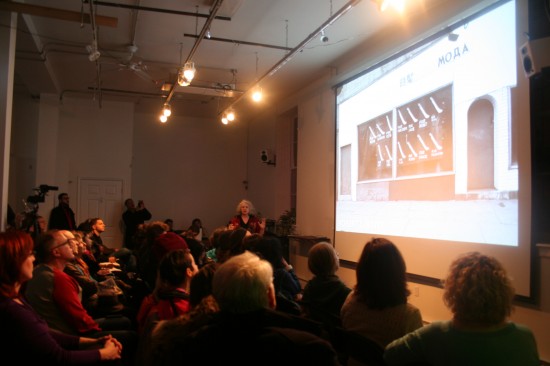
Forum recalls the ferment of Fashion Moda
Three participants in a radical artistic collaboration in the late 1970s were reunited at the Bronx Documentary Center on Feb. 16 to recall a time when a shabby storefront near the Hub became a hot spot of the New York art world.
Fashion Moda, where artists, musicians and performers created and displayed their work, was the site of “one of the most significant American Renaissances in a long time,” said Jorge “Popmaster Fabel” Pabon. Pabon, a pioneer of hip-hop dance, was joined by photographer Lisa Kahane and artist Emily Dickson on a panel moderated by journalist and critic Ed Morales.
Founded in 1978 by Stefan Eins in an abandoned Salvation Army store on Third Avenue near 147th Street, Fashion Moda brought graffiti art and hip-hop to the attention of a downtown art world focused on minimalism and abstraction. It recorded the destruction of the South Bronx and the refusal of its residents to succumb to despair. And it advanced the reputations of artists like Keith Haring, John Ahearn, Rigoberto Torres, Lady Pink, Crash and Daze.
Dickson revisited the installation of her “City Maze,” built of graffiti-covered cardboard boxes, showing a video that followed local children who explored its labrynths. FashionModa, she said, “was like the message from the ghetto.” It said, “‘We’re here and we’re really dynamic.’”
Kahane presented a slide show of her photographs that included scenes of abandoned and burning buildings and of children playing in the rubble of vacant lots surrounded by abandoned apartment houses.
She said this era in the Bronx is excluded from the history books, and she hoped that the audience would learn more about the borough’s history from the presentation.
“There are wonderful books about ‘Oh, the beautiful Bronx,’” she said, but “they stop at 1960. It wasn’t that the borough fell into the sea, but the history stops.”
Kahane also wanted the audience to understand that despite the South Bronx’s reputation as an icon of urban decay, it was an important creative hub. Fashion Moda may be gone, she said, but in neighborhoods like Hunts Point despite economic devastation, people are creating and collaborating, as they did three decades ago.
Fashion Moda was a home away from home, Pabon said. “It gave us a place to do our thing,” fostering what he called “American folk art” like graffiti and hip-hop.
To get a feel for the ferment of the time, Kahane advised, go to an unfamiliar place and learn to understand it.
“Talk to people you don’t know, find the energy that you find appealing but is coming from somewhere you don’t understand, go there and see what it’s really about,” she said.
“I’m astonished. We couldn’t imagine this kind of place,” said Brooklyn resident Laetitia Vanni, who, along with her husband Jean was led to the panel by an earlier visit to the Documentary Center to see the Seis del Sur Exhibit and attend the center’s Valentine’s Day event.
Solen Fluzin, 23, an exchange student from France who regularly visits the Documentary Center, said she didn’t know what to expect when she arrived for the Fashion Moda discussion. Now, she said, “It makes me want to know more and explore this part of NYC that is often stigmatized.”

[…] Artists recapture South Bronx history. […]